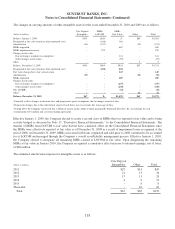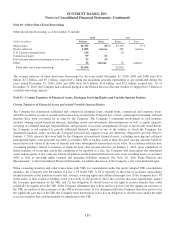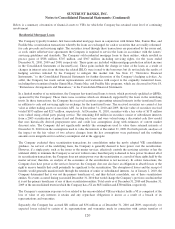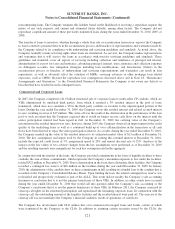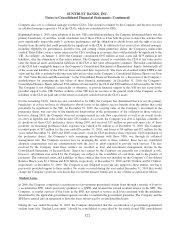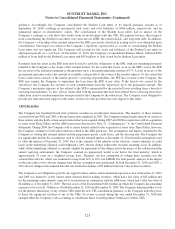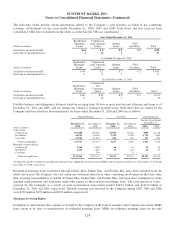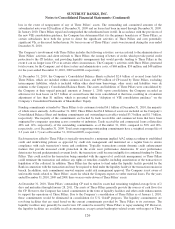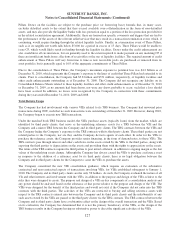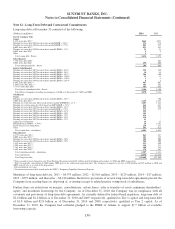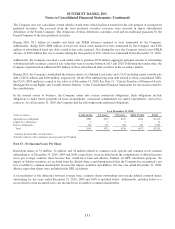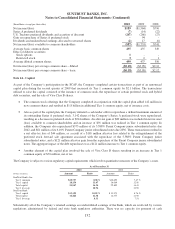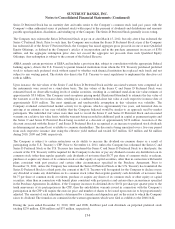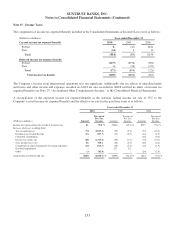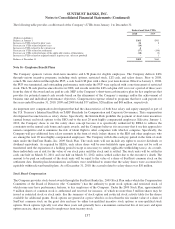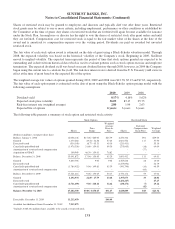SunTrust 2010 Annual Report Download - page 144
Download and view the complete annual report
Please find page 144 of the 2010 SunTrust annual report below. You can navigate through the pages in the report by either clicking on the pages listed below, or by using the keyword search tool below to find specific information within the annual report.
SUNTRUST BANKS, INC.
Notes to Consolidated Financial Statements (Continued)
At December 31, 2010, the Company had $972 million in senior financing outstanding to VIEs, which was classified
within trading assets on the Consolidated Balance Sheets and carried at fair value. These VIEs had entered into TRS
contracts with the Company with outstanding notional amounts of $969 million at December 31, 2010 and the Company
had entered into mirror TRS contracts with its third parties with the same outstanding notional amounts. At
December 31, 2010, the fair values of these TRS derivative assets and derivative liabilities were $34 million and $32
million, respectively, reflecting the pass-through nature of these structures. The notional amounts of the TRS contracts
with the VIEs represent the Company’s maximum exposure to loss, although such exposure to loss has been mitigated
via the TRS contracts with the third parties. The Company has not provided any support that it was not contractually
obligated to for the year ended December 31, 2010. For additional information on the Company’s TRS with these VIEs,
see Note 17, “Derivative Financial Instruments,” to the Consolidated Financial Statements.
Community Development Investments
As part of its community reinvestment initiatives, the Company invests almost exclusively within its footprint in multi-
family affordable housing developments and other community development entities as a limited and/or general partner
and/or a debt provider. The Company receives tax credits for its partnership investments. The Company has determined
that these partnerships are VIEs when it does not own 100% of the entity because the holders of the equity investment at
risk do not have the power through voting rights or similar rights to direct the activities of the entity that most
significantly impact the entity’s economic performance. Accordingly, the Company’s general partner, limited partner,
and/or debt interests are VIs that the Company evaluates for purposes of determining whether the Company is the
primary beneficiary. During 2010 and 2009, the Company did not provide any financial or other support to its
consolidated or unconsolidated investments that it was not previously contractually required to provide.
For some partnerships, the Company operates strictly as a general partner and, as such, has both (1) the power to direct
the activities of the VIE that most significantly impact the entity’s economic performance and (2) the obligation to
absorb losses of and the right to receive benefits from the entity that could potentially be significant to the VIE.
Accordingly, the Company consolidates these partnerships on its Consolidated Balance Sheets. As the general partner,
the Company typically guarantees the tax credits due to the limited partner and is responsible for funding construction
and operating deficits. As of December 31, 2010 and December 31, 2009, total assets, which consist primarily of fixed
assets and cash attributable to the consolidated partnerships, were $8 million and $14 million, respectively, and total
liabilities, excluding intercompany liabilities, were $1 million and $3 million, respectively. Security deposits from the
tenants are recorded as liabilities on the Company’s Consolidated Balance Sheets. The Company maintains separate cash
accounts to fund these liabilities and these assets are considered restricted. The tenant liabilities and corresponding
restricted cash assets were de minimis as of December 31, 2010 and December 31, 2009. While the obligations of the
general partner are generally non-recourse to the Company, as the general partner, the Company may from time to time
step in when needed to fund deficits. During 2010 and 2009, the Company did not provide any significant amount of
funding as the general partner or to cover any deficits the partnerships may have generated.
For other partnerships, the Company acts only in a limited partnership capacity. The Company has determined that it is
not the primary beneficiary of these partnerships because it does not have the power to direct the activities of the entity
that most significantly impact the entity’s economic performance. The Company accounts for its limited partner interests
in accordance with the accounting guidance for investments in affordable housing projects. The general partner or an
affiliate of the general partner provides guarantees to the limited partner, which protects the Company from losses
attributable to operating deficits, construction deficits and tax credit allocation deficits. Partnership assets of $1.1 billion
in these partnerships were not included in the Consolidated Balance Sheets at December 31, 2010 and December 31,
2009. These limited partner interests had carrying values of $202 million and $218 million at December 31, 2010 and
December 31, 2009, respectively, and are recorded in other assets on the Company’s Consolidated Balance Sheets. The
Company’s maximum exposure to loss for these limited partner investments totaled $458 million and $468 million at
December 31, 2010 and December 31, 2009, respectively. The Company’s maximum exposure to loss would be borne
by the loss of the limited partnership equity investments along with $222 million and $219 million of loans issued by the
Company to the limited partnerships at December 31, 2010 and December 31, 2009, respectively. The difference
between the maximum exposure to loss and the investment and loan balances is primarily attributable to the unfunded
equity commitments. Unfunded equity commitments are amounts that the Company has committed to the partnerships
upon the partnerships meeting certain conditions. When these conditions are met, the Company will invest these
additional amounts in the partnerships.
128


